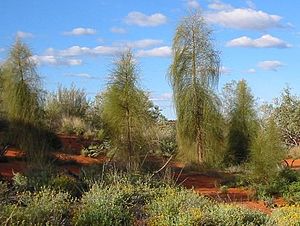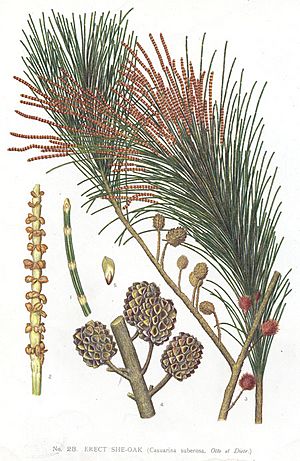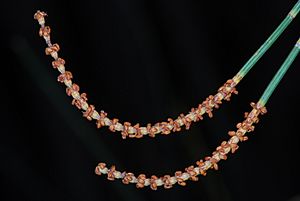Sheoak facts for kids
Quick facts for kids Sheoak |
|
|---|---|
 |
|
| Allocasuarina decaisneana in Central Australia | |
| Scientific classification |
|
| Kingdom: | Plantae |
| Clade: | Tracheophytes |
| Clade: | Angiosperms |
| Clade: | Eudicots |
| Clade: | Rosids |
| Order: | Fagales |
| Family: | Casuarinaceae |
| Genus: | Allocasuarina L.A.S.Johnson |
| Type species | |
| Allocasuarina torulosa (Aiton) L.A.S.Johnson |
|
| Species | |
|
61 species; see text. |
|
Allocasuarina is a genus of trees in the flowering plant family Casuarinaceae. They are endemic to Australia, occurring primarily in the south. Like the closely related genus Casuarina, they are commonly called sheoaks or she-oaks.
Wilson and Johnson distinguish the two very closely related genera, Casuarina and Allocasuarina on the basis of:
- Casuarina: the mature samaras being grey or yellow-brown, and dull; cone bracteoles thinly woody, prominent, extending well beyond cone body, with no dorsal protuberance;
- Allocasuarina: the mature samaras being red-brown to black, and shiny; cone bracteoles thickly woody and convex, mostly extending only slightly beyond cone body, and usually with a separate angular, divided or spiny dorsal protuberance.
Description
They are trees or shrubs that are notable for their long, segmented branchlets that function as leaves. Formally termed cladodes, these branchlets somewhat resemble pine needles, although sheoaks are flowering plants. The leaves are reduced to minute scales encircling each joint. Fallen cladodes form a dense, soft mat beneath sheoaks, preventing the development of undergrowth (a phenomenon known as allelopathy) and making sheoak woods remarkably quiet.
Another characteristic feature are the spiny "cones", about the size of an acorn but with a texture more resembling a conifer cone. However, sheoak "cones" are a woody fruit. Male specimens bear no fruit and are sometimes colloquially referred to as a "heoak".
As with legumes, sheoak roots possess nodules containing symbiotic nitrogen fixing bacteria; together with their highly drought-adapted foliage, this enables sheoaks to thrive in very poor soil and semi-arid areas. However, sheoaks are much less bushfire-tolerant than eucalypts.
Fossils of closely related species have been found dating back to the time of Gondwana.
Uses
The hard wood and rich texture makes sheoak wood popular among wood-turners. Sheoak wood is also regarded as an excellent firewood as it burns with very little ash.
Because of its ability to grow and develop extensive root systems in very poor or sandy soils, and to completely cover the ground with its "needles", it is often used to stabilise soils in erosion prone areas, or on sand dunes. Sheoak is also used as an ornamental shrub, although for this purpose the mat of "needles" may become a nuisance and must be carefully considered.
List of species
Allocasuarina comprises the following species:
- Allocasuarina acuaria
- Allocasuarina acutivalvis
- Allocasuarina brachystachya
- Allocasuarina campestris (tamma)
- Allocasuarina corniculata
- Allocasuarina crassa (Cape Pillar sheoak)
- Allocasuarina decaisneana (Desert oak)
- Allocasuarina decussata (Karri oak)
- Allocasuarina defungens
- Allocasuarina dielsiana (Northern sheoak)
- Allocasuarina diminuta
- Allocasuarina distyla (Scrub sheoak)
- Allocasuarina drummondiana
- Allocasuarina duncanii (Duncan's sheoak)
- Allocasuarina emuina (Emu Mountain sheoak)
- Allocasuarina eriochlamys
- Allocasuarina fibrosa (Woolly sheoak)
- Allocasuarina filidens (Mount Beerwah sheoak)
- Allocasuarina fraseriana (Western sheoak)
- Allocasuarina glareicola
- Allocasuarina globosa
- Allocasuarina grampiana
- Allocasuarina grevilleoides
- Allocasuarina gymnanthera
- Allocasuarina helmsii
- Allocasuarina huegeliana (Rock sheoak)
- Allocasuarina humilis (Dwarf sheoak)
- Allocasuarina hystricosa Wege
- Allocasuarina inophloia (Hairy oak)
- Allocasuarina lehmanniana (Dune sheoak)
- Allocasuarina littoralis (Black sheoak)
- Allocasuarina luehmannii (Bull-oak or buloke)
- Allocasuarina mackliniana (Western sheoak)
- Allocasuarina media
- Allocasuarina microstachya
- Allocasuarina misera
- Allocasuarina monilifera
- Allocasuarina muelleriana (Slaty sheoak)
- Allocasuarina nana
- Allocasuarina ophiolitica
- Allocasuarina paludosa (Scrub sheoak)
- Allocasuarina paradoxa
- Allocasuarina pinaster
- Allocasuarina portuensis
- Allocasuarina pusilla (Dwarf sheoak)
- Allocasuarina ramosissima
- Allocasuarina rigida
- Allocasuarina robusta
- Allocasuarina rupicola
- Allocasuarina scleroclada
- Allocasuarina simulans
- Allocasuarina spinosissima
- Allocasuarina striata (Small bull-oak)
- Allocasuarina tessellata
- Allocasuarina thalassoscopica
- Allocasuarina thuyoides (Horned she-oak)
- Allocasuarina tortiramula (Twisted sheoak)
- Allocasuarina torulosa (Forest sheoak)
- Allocasuarina trichodon
- Allocasuarina verticillata (Drooping sheoak)
- Allocasuarina zephyrea
Species names with uncertain taxonomic status
The status of the following species is unresolved:
- Allocasuarina decemilinanana
See also
 In Spanish: Allocasuarina para niños
In Spanish: Allocasuarina para niños



